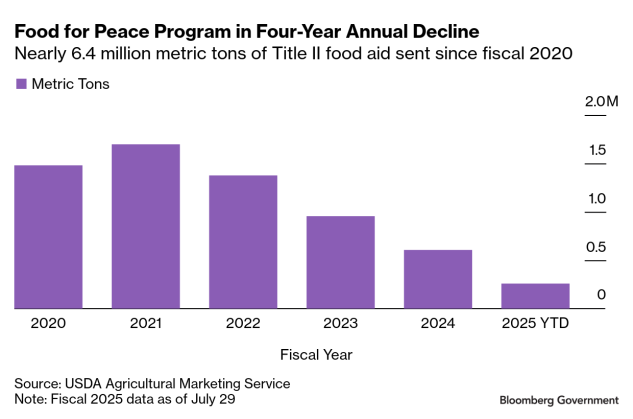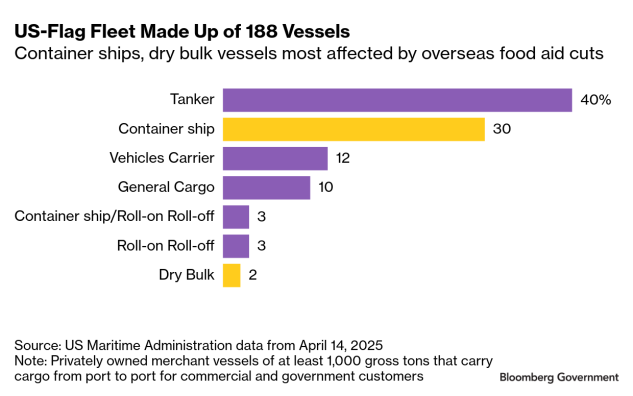The abrupt pause on American humanitarian aid this year ground sections of US cargo shipping to a halt, sending some in the industry into panic mode and raising doubts about President Donald Trump’s claim that he’ll get the American flag flying on more vessels than ever.
Government-sponsored foreign aid represents the bulk of cargo orders for some US shippers, and contracts worth hundreds of millions of dollars were plunged into limbo when Trump dismantled the US Agency for International Development. During the 2024 fiscal year, 606,301 metric tons of food aid cargo were ordered through USAID’s Title II Food for Peace program. So far this fiscal year—as of July 29—just 259,000 metric tons have been ordered.
Laws mandate that the Pentagon ship all of its cargo—and that civilian agencies like USAID ship half their orders—on US-flagged vessels. This has long helped privately owned American shippers stay afloat in a competitive market where they get outbid by cheaper rivals from other nations.
US shipping lobbyists in interviews with Bloomberg Government said they’ve struggled to get answers from the State Department, which ostensibly took over the government’s largest humanitarian aid program. And Republicans in Congress have so far failed to revive programs that shipping companies rely on.
Industry insiders say voiding such foreign aid cargo orders would jeopardize jobs, cripple military sealift capabilities, and clash with Trump’s declared vision of boosting the US shipping industry.
“If the cargo isn’t there, you can’t sustain a US-flag vessel,” said Torben Svenningsen, chief commercial officer of Norfolk, Va.-based Maersk Line, Ltd., who said USAID orders account for a major portion of the company’s revenue. “If food aid isn’t there in some form in the future, there’s no possible way that you can grow the future fleet.”
That sentiment was echoed in interviews with 12 senior US shipping company executives, lobbyists, consultants, a naval historian, and a union representative about the status of international relief and what it means for American merchant marines.
As shipping companies respond to sudden changes in government policy on overseas aid, several industry representatives said the cuts conflict with Trump’s promise to support the maritime industry. In his March joint address to Congress, the president underscored his intention to be a champion for US merchant marines.
“We are also going to resurrect the American shipbuilding industry, including commercial shipbuilding and military ships,” he said at the time. The president signed an executive order a month later, titled “Restoring America’s Maritime Dominance,” that outlined plans to expand the US-flag fleet.
On July 1, Secretary of State
Building more ships to sail under the American flag hinges on the quantity of cargo orders, mariner chiefs and industry advocates said. Food aid can account for the majority of what some freighters deliver in a year, and they said stripping those orders runs counter to plans for expansion.
Three food-aid shipping lobbyists, who spoke under the condition of anonymity because of fears of rebuke from the Trump administration, said they don’t know what the remake of the government’s largest food aid program will be because no one in the State Department will say.
One called communications a “black hole,” saying they can’t find people to talk to. Another said some ships have unpaid invoices for completed orders, and they don’t have anyone to send bills to. The State Department laid off over 1,300 employees on July 11 following a Supreme Court ruling that the Trump administration could press ahead with plans to cut the size of the federal workforce.
Read more: State Department Starts Laying Off 1,300 Staff in Major Purge
A State Department spokesperson, in a written statement sent to Bloomberg Government, said it is committed to administering Food for Peace and maintaining its ongoing partnerships with American shippers and farmers.
State has provided $52 million to the World Food Program to deliver emergency goods assistance from American farmers and producers to people in need in the Democratic Republic of Congo, Ethiopia, Haiti, and Djibouti, the spokesperson added. Under the contract award, WFP will distribute 12,702 metric tons to support more than 1.9 million people.
American ships can carry hundreds of thousands of metric tons of food aid in a year. Tenders for food aid programs adopted by State have shriveled this year, according to data from the USDA Agricultural Marketing Service.
Under the Food for Peace program, over 600,000 metric tons of food aid cargo were ordered in fiscal year 2024. From Oct. 1 to July 29 — more than three quarters through the 2025 fiscal year, orders for the program are less than half. The data didn’t break out quarterly spending for previous fiscal years.
Rubio wrote in the July 1 USAID-closure announcement the “near-infinite taxpayer budget” for international assistance has failed to grow American influence and that instability has only worsened in recipient countries.
“We will not apologize for recognizing America’s longstanding commitment to life-saving humanitarian aid and promotion of economic development abroad must be in furtherance of an America First foreign policy,” he wrote in the post titled “Making Foreign Aid Great Again.”
Shippers are worried that the program is destined to shutter under the State Department. They are calling Capitol Hill for help.
Awaiting Congressional Action
Republicans in Congress have sought to transfer Food for Peace to the Department of Agriculture, which runs smaller aid programs that remain operational.
Sen.
Moran has criticized USAID’s handling of the program but earlier this year said on the Senate floor the aid programs are essential for farmers in his home state and millions of hungry people around the world.
Appropriators in both chambers considered, but ultimately omitted, versions of the measures in fiscal 2026 agriculture spending bills. Senators included $1.5 billion for Food for Peace Title II and $1 million for a study for the costs associated with transferring the program to USDA in their budget measure passed in August. The full House has yet to vote on its agriculture spending language, which would provide only $900 million to the program.
With the start of a new fiscal year fast approaching, mariner and farmer lobbyists are looking for any legislation that may act as a vehicle for the bills, said Kim Z Cooper, North American Miller’s Association vice president of government affairs.
“Ideally, the bills to transfer Food for Peace to USDA would be included in a farm bill as that is where the program is authorized,” Cooper said in a written statement. “Given the uncertainty around a farm bill this fall, farmers, millers, and mariners will be pushing to move Food for Peace to USDA in any legislative vehicle.”
GOP lawmakers called on the State Department to breathe life into the program earlier this year.
Agriculture Committee Chairs Sen.
The same ships supported by food aid also carry uniforms, food, and medical supplies for the military. American merchant marines make up the Pentagon’s sealift capabilities, and industry concerns about policies hurting the US fleet are closely tied to defense concerns.
The Chinese international shipping fleet has over 6,000 ships, according to United Nations Trade and Development data. The American fleet only had 188 vessels as of April, according to the Maritime Administration.
Despite the push by some lawmakers and industry representatives for Food for Peace Title II to move over to USDA, a White House official last week told Bloomberg Government the foreign aid program “will remain at State” and not be moved under the Department of Agriculture’s control.
Read More: State Department to Retain Key Food Program in Snub to Congress
The Pentagon declined to comment. The Transportation Department and USDA did not respond to requests for comment.
Trump’s Vocal Support
Trump’s stated goal of supporting the expansion of the US-flag fleet earlier this year won widespread industry support, but uncertainty over food aid orders continues to dog shipping companies that must plan operations and place vessel orders years in advance.
Roland Rexha, secretary-treasurer for Marine Engineers’ Beneficial Association, said the president’s flag bearing has spread optimism among mariners — and there have been early signs of success. Hanwha Shipping ordered a liquefied natural gas carrier from a Philadelphia shipyard in July, the first of its kind built in the US since the 1970s.
“Trump not only mentioned maritime. He spoke of the revitalization of maritime,” said Rexha, who worked on a US-flag ship carrying food aid along the coast of Africa. “As an industry, we’re excited. We’re also cautious.”
As the industry saying goes, cargo is king. You can’t keep a ship moving, pay your mariners, or sustain — let alone expand — a fleet without orders, said Mark Vlaun, vice president of government relations at American Roll-On Roll-Off Carrier Group.
“Cargo is absolutely the most important factor in growing the United States flag fleet and in creating jobs for the American maritime workforce,” Vlaun said. “Cargo is that important.”
— With assistance from
Reporter on this story:
To contact the editors responsible for this story:


